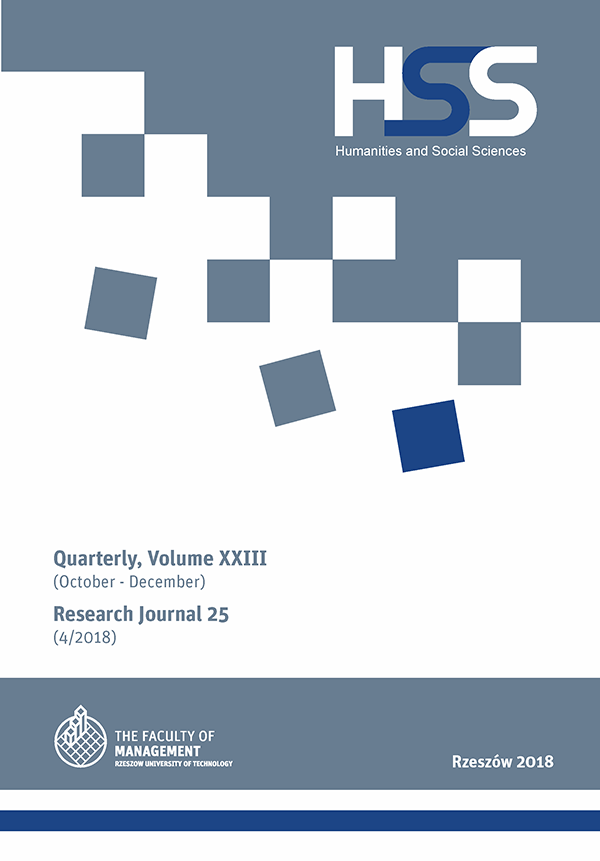Abstract
Taking leading positions in companies, managers and entrepreneurs are inevitably perceived as bearers of certain values and work style of the organization they serve. On the other hand, they are usually actors of the business world, strongly emphasizing their individuality and causative abilities. Reconciling these not always congruent roles and motives is not an easy issue. However, in a more or less conscious manner, actors try to form a relatively consistent self-image. In the spatial context, the instruments for efficient self-presentation are arrangements of offices, possession, and display of status symbols, appropriate for the occupying position dress code, as well as various types of visual information available to the internal and external stakeholders of the organization. For that content to be clear and credible, professional image management specialist increasingly comes to the aid. The below article describes the issues related business actors media-image management. However, the author describes commercial photography services who offers professionally prepared concepts of a business actor and their job as the only subject of his research. The data used in the study were collected at two time points; in Jun.2013 and in Jan./Feb. 2017, and the analysis was based on the grounded theory methodology. As a result of the coding procedures described in the article, the researcher has generated several categories relating to the content and form of images of business leaders; entrepreneurs and managers.
References
Clarke A., Situational Analysis: Grounded Theory after the Postmodern Turn. Sage, Thousand Oaks 2005.
Davidson J., (In)visible (in)tangibles: Visual Portraits of the Business Élite, “Accounting, Organizations and Society” 2010, Vol. 35(2), p. 165–183.
Drucker P., Practice of Management, Harper&Row, New York 1954.
Elsbach K.D., Interpreting Workplace Identities: the Role of Office Décor, “Journal of Organizational Behavior” 2004, Vol. 25(1), p. 99–128.
Giddens A., The Consequences of Modernity, Polity Press, Cambridge 1990.
Glaser B.G., Theoretical Sensitivity: Advances in the Methodology of Grounded Theory, The Sociology Press, California 1978.
Glaser B.G., Strauss A.L., The Discovery of Grounded Theory: Strategies for Qualitative Research. New Brunswick, Aldine, London 1967.
Goffman E., Symbols of Class Status, “British Journal of Sociology” 1951, Vol. 2(4), p. 294–304.
Goffman E., The Nature of Deference and Demeanor, “American Anthropologist” 1956, Vol. 58(3), p. 473–502.
Goffman E., The Presentation of Self in Everyday Life, Anchor, Doubleday 1959.
Goffman E., Encounters: Two Studies in the Sociology of Interaction, Bobbs-Merill, Indianapolis 1961.
Goffman E., Behavior in Public Places. Notes on the Social Organization of Gatherings, The Free Press, New York 1963.
Goffman E., Interaction ritual: Essays on Face-to-Face Behavior, Aldine, New Brunswick, London 1967.
Goffman E., Relations in Public: Microstudies of the Public Order, Penguin, Ringwood 1972.
Goffman E., Gender Advertisements, Harper Torchbook, New York 1987.
Gorzko M., Procedury i emergencja. O metodologii klasycznych odmian teorii ugruntowanej [Procedures and Emergence. About the Methodology of Classic Varieties of Grounded Theory], Wydawnictwo Naukowe Uniwersytetu Szczecińskiego, Szczecin 2008.
Guthey E., Jackson B., CEO portraits and the authenticity paradox, “Journal of Management Studies” 2005, Vol. 42(5), p. 1057–1082.
Hall E.T., The Hidden Dimension. Doubleday, New York 1966.
Hatch M.J., The symbolics of office design: An empirical exploration [in:] Symbols and artifacts: Views of the corporate landscape, ed. P. Gagliardi, Walter de Gruyter, Berlin 1990, p. 129–146.
Judge T.A., Cable D.M., The Effect of Physical Height on Workplace Success and Income: Preliminary Test of a Theoretical Model, “Journal of Applied Psychology” 2004, Vol. 89(3), p. 428–441.
Konecki K.T., Studia z metodologii teorii ugruntowanej [Studies in Qualitative Methodology: Grounded Theory], PWN, Warszawa 2000.
Konecki K.T., Wizualna teoria ugruntowana. Podstawowe zasady i procedury [Visual Grounded Theory. The Basic Rules and Procedures], „Przegląd Socjologii Jakościowej” 2012, Vol. 8(1), p. 12–45.
Lawrence J., Engaging Gen Y: Leading Well Across the Generations, Grove Books, Cambridge 2012.
Mintzberg H., The Manager’s Job: Folklore and Fact, “Harvard Business Review” 1975, July–August.
Nath V., Dress Codes and Appearance Norms at Work: Body Supplements, Body Modifications and Aesthetic Labour, Acas, London 2016.
Nogalski B., Śniadecki J., Kształtowanie umiejętności menedżerskich [Shaping managerial skills], TNOiK, Bydgoszcz 1998.
Ornstein S., Impression Management Through Office Design [in:] Impression Management in the Organization, ed. R.A. Giacalone, P. Rosenfeld, Erlbaum, Hillsdale, NJ 1989.
Pratt M.G., Rafaeli A., Organizational Dress as a Symbol of Multilayered Social Identities, “Academy of Management Journal” 1997, Vol. 40(4), p. 862–898.
Sommer R., Personal Space: The Behavioural Basis of Design, Prentice Hall, New Jersey, Englewood Cliffs 1969.
Strauss A.L., Corbin J.M., Basics of Qualitative Research: Techniques and Procedures for Developing Grounded Theory, Sage, London 1998.
Veblen T., The Theory of the Leisure Class, Macmillan, New York 1912.
Zhang Z., Spicer A., “Leader, you first” The Everyday Production of Hierarchical Space in a China Bureaucracy, Human Relations, 2014, Vol. 67(6), p. 739–762.
INTERNET SOURCES
Mears A., The Potlatch Revisited: Distinction and Destruction among the New Global Elite, 2017 (draft), http://faculty.chicagobooth.edu/workshops/orgs-markets/pdf/Mears.pdf (DOA March 2017).
Tulgan B., Meet the Generation Z: The second generation within the giant “Millennial” cohort, 2013, http://rainmakerthinking.com/assets/uploads/2013/10/Gen-Z-Whitepaper.pdf (DOA March 2017).

